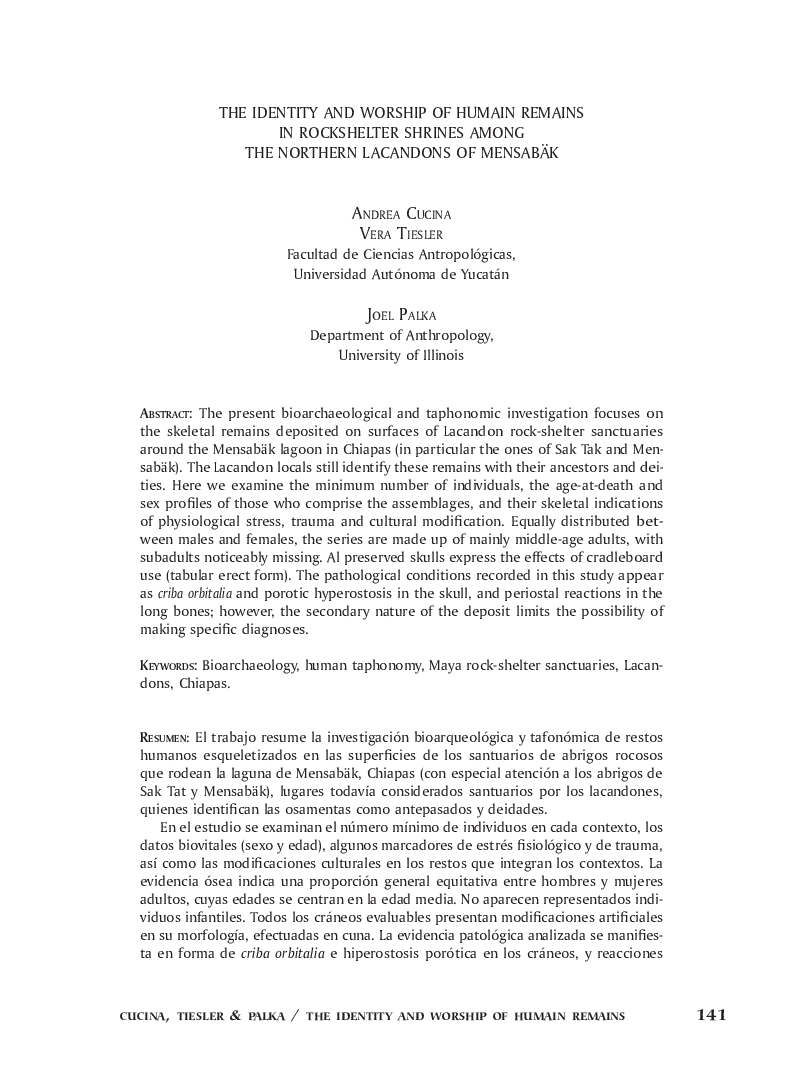| کد مقاله | کد نشریه | سال انتشار | مقاله انگلیسی | نسخه تمام متن |
|---|---|---|---|---|
| 1158010 | 959330 | 2015 | 29 صفحه PDF | دانلود رایگان |
The present bioarchaeological and taphonomic investigation focuses on the skeletal remains deposited on surfaces of Lacandon rock-shelter sanctuaries around the Mensabäk lagoon in Chiapas (in particular the ones of Sak Tak and Mensabäk). The Lacandon locals still identify these remains with their ancestors and deities. Here we examine the minimum number of individuals, the age-at-death and sex profiles of those who comprise the assemblages, and their skeletal indications of physiological stress, trauma and cultural modification. Equally distributed between males and females, the series are made up of mainly middle-age adults, with subadults noticeably missing. Al preserved skulls express the effects of cradleboard use (tabular erect form). The pathological conditions recorded in this study appear as criba orbitalia and porotic hyperostosis in the skull, and periostal reactions in the long bones; however, the secondary nature of the deposit limits the possibility of making specific diagnoses.
ResumenEl trabajo resume la investigación bioarqueológica y tafonómica de restos humanos esqueletizados en las superficies de los santuarios de abrigos rocosos que rodean la laguna de Mensabäk, Chiapas (con especial atención a los abrigos de Sak Tat y Mensabäk), lugares todavía considerados santuarios por los lacandones, quienes identifican las osamentas como antepasados y deidades.En el estudio se examinan el número mínimo de individuos en cada contexto, los datos biovitales (sexo y edad), algunos marcadores de estrés fisiológico y de trauma, así como las modificaciones culturales en los restos que integran los contextos. La evidencia ósea indica una proporción general equitativa entre hombres y mujeres adultos, cuyas edades se centran en la edad media. No aparecen representados individuos infantiles. Todos los cráneos evaluables presentan modificaciones artificiales en su morfología, efectuadas en cuna. La evidencia patológica analizada se manifiesta en forma de criba orbitalia e hiperostosis porótica en los cráneos, y reacciones periostales en los huesos largos, aunque el origen secundario de los depósitos limita un diagnóstico preciso. Marcas antrópicas halladas en algunos segmentos hablan de violencia peri mortem y posibles procesamientos póstumos de los cuerpos.
Journal: Estudios de Cultura Maya - Volume 45, Issue 45, 2015, Pages 141–169
